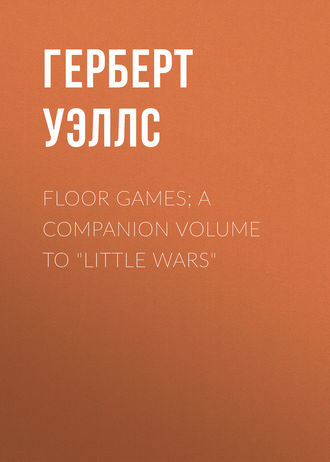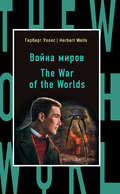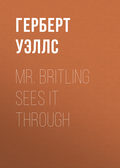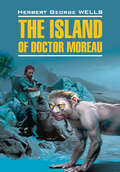
Герберт Джордж Уэллс
Floor Games; a companion volume to "Little Wars"
Then we have "beefeaters," (Footnote; The warders in the Tower of London are called "beefeaters"; the origin of the term is obscure.) Indians, Zulus, for whom there are special rules. We find we can buy lead dogs, cats, lions, tigers, horses, camels, cattle, and elephants of a reasonably corresponding size, and we have also several boxes of railway porters, and some soldiers we bought in Hesse-Darmstadt that we pass off on an unsuspecting home world as policemen. But we want civilians very badly. We found a box of German from an exaggerated curse of militarism, and even the grocer wears epaulettes. This might please Lord Roberts and Mr. Leo Maxse, but it certainly does not please us. I wish, indeed, that we could buy boxes of tradesmen: a blue butcher, a white baker with a loaf of standard bread, a merchant or so; boxes of servants, boxes of street traffic, smart sets, and so forth. We could do with a judge and lawyers, or a box of vestrymen. It is true that we can buy Salvation Army lasses and football players, but we are cold to both of these. We have, of course, boy scouts. With such boxes of civilians we could have much more fun than with the running, marching, swashbuckling soldiery that pervades us. They drive us to reviews; and it is only emperors, kings, and very silly small boys who can take an undying interest in uniforms and reviews.
And lastly, of our railways, let me merely remark here that we have always insisted upon one uniform gauge and everything we buy fits into and develops our existing railway system. Nothing is more indicative of the wambling sort of parent and a coterie of witless, worthless uncles than a heap of railway toys of different gauges and natures in the children's playroom. And so, having told you of the material we have, let me now tell you of one or two games (out of the innumerable many) that we have played. Of course, in this I have to be a little artificial. Actual games of the kind I am illustrating here have been played by us, many and many a time, with joy and happy invention and no thought of publication. They have gone now, those games, into that vaguely luminous and iridescent into which happiness have tried out again points in world of memories all love-engendering must go. But we our best to set them and recall the good them here.
Section II
THE GAME OF THE WONDERFUL ISLANDS
In this game the floor is the sea. Half – rather the larger half because of some instinctive right of primogeniture – is assigned to the elder of my two sons (he is, as it were, its Olympian), and the other half goes to his brother. We distribute our boards about the sea in an archipelagic manner. We then dress our islands, objecting strongly to too close a scrutiny of our proceedings until we have done. Here, in the illustration, is such an archipelago ready for its explorers, or rather on the verge of exploration. There are altogether four islands, two to the reader's right and two to the left, and the nearer ones are the more northerly; it is as many as we could get into the camera. The northern island to the right is most advanced in civilization, and is chiefly temple. That temple has a flat roof, diversified by domes made of half Easter eggs and cardboard cones. These are surmounted by decorative work of a flamboyant character in plasticine, designed by G. P. W. An oriental population crowds the courtyard and pours out upon the roadway. Note the grotesque plasticine monsters who guard the portals, also by G. P. W., who had a free hand with the architecture of this remarkable specimen of eastern religiosity. They are nothing, you may be sure, to the gigantic idols inside, out of the reach of the sacrilegious camera. To the right is a tropical thatched hut. The thatched roof is really that nice ribbed paper that comes round bottles – a priceless boon to these games. All that comes into the house is saved for us. The owner of the hut lounges outside the door. He is a dismounted cavalry-corps man, and he owns one cow. His fence, I may note, belonged to a little wooden farm we bought in Switzerland. Its human inhabitants are scattered; its beasts follow a precarious living as wild guinea-pigs on the islands to the south.
Your attention is particularly directed to the trees about and behind the temple, which thicken to a forest on the further island to the right. These trees we make of twigs taken from trees and bushes in the garden, and stuck into holes in our boards. Formerly we lived in a house with a little wood close by, and our forests were wonderful. Now we are restricted to our garden, and we could get nothing for this set out but jasmine and pear. Both have wilted a little, and are not nearly such spirited trees as you can make out of fir trees, for instance. It is for these woods chiefly that we have our planks perforated with little holes. No tin trees can ever be so plausible and various and jolly as these. With a good garden to draw upon one can make terrific sombre woods, and then lie down and look through them at lonely horsemen or wandering beasts.
That further island on the right is a less settled country than the island of the temple. Camels, you note, run wild there; there is a sort of dwarf elephant, similar to the now extinct kind of which one finds skeletons in Malta, pigs, a red parrot, and other such creatures, of lead and wood. The pear-trees are fine. It is those which have attracted white settlers (I suppose they are), whose thatched huts are to be seen both upon the beach and in-land. By the huts on the beach lie a number of pear-tree logs; but a raid of negroid savages from the to the left is in the only settler is the man in a adjacent island progress, and clearly visible rifleman's uniform running inland for help. Beyond, peeping out among the trees, are the supports he seeks.
These same negroid savages are as bold as they are ferocious. They cross arms of the sea upon their rude canoes, made simply of a strip of cardboard. Their own island, the one to the south-left, is a rocky wilderness containing caves. Their chief food is the wild-goat, but in pursuit of these creatures you will also sometimes find the brown bear, who sits – he is small but perceptible to the careful student – in the mouth of his cave. Here, too, you will distinguish small guinea pig-like creatures of wood, in happier days the inhabitants of that Swiss farm. Sunken rocks off this island are indicated by a white foam which takes the form of letters, and you will also note a whirlpool between the two islands to the right.
Finally comes the island nearest to the reader on the left. This also is wild and rocky, inhabited not by negroid blacks, but by Indians, whose tents, made by F. R. W. out of ordinary brown paper and adorned with chalk totems of a rude and characteristic kind, pour forth their fierce and well-armed inhabitants at the intimation of an invader. The rocks on this island, let me remark, have great mineral wealth. Among them are to be found not only sheets and veins of silver paper, but great nuggets of metal, obtained by the melting down of hopelessly broken soldiers in an iron spoon. Note, too, the peculiar and romantic shell beach of this country. It is an island of exceptional interest to the geologist and scientific explorer. The Indians, you observe, have domesticated one leaden and one wooden cow.







